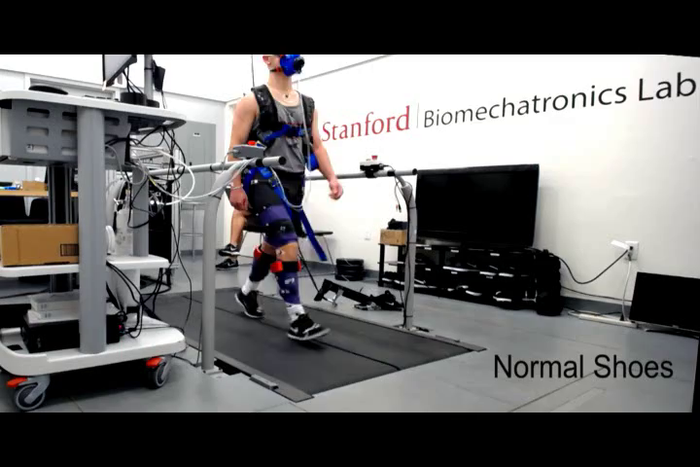Research that examines how the body adapts to new movements is shedding new light on how the nervous system learns, and could help to inform a wide range of applications, from customized rehabilitation and athletic training to wearable systems for healthcare. The research is published this week in the journal Current Biology.

Credit: Stanford Biomechatronics Lab
Research that examines how the body adapts to new movements is shedding new light on how the nervous system learns, and could help to inform a wide range of applications, from customized rehabilitation and athletic training to wearable systems for healthcare. The research is published this week in the journal Current Biology.
“How does our brain figure out how to best move our body? It turns out that this can be a challenging problem for the nervous system, considering we have hundreds of muscles that can be coordinated hundreds of times per second—with more possible coordination patterns to choose from than moves on a chessboard,” says study senior author and SFU professor Max Donelan, director of SFU’s Locomotion Lab.
“We often experience changes to our body and our environment. Perhaps you enjoy a long run on a Saturday morning—your muscles may fatigue as the length of the run increases. Perhaps you choose to run on the beach on vacation—the sand may be uneven and loose in comparison to the pavement on the sidewalk. While we might register that these changes have occurred, we might not appreciate how our body adapts to these changes.”
Donelan’s team of neuroscientists that study motor learning collaborated with a Stanford University team of mechanical engineers that design human-robot systems. Together, they tracked the walking characteristics of study participants wearing exoskeletons.
Findings
Researchers found that the nervous system solves the problem of learning a new movement coordination pattern by first exploring and evaluating many different coordination patterns. This exploration was measured as a general increase in variability spanning the levels of the whole movement, joint, and muscle.
With experience, the nervous system adapts specific aspects of movement and simultaneously decreases variability along these aspects. The researchers also found that these adaptive changes improved movement overall, reducing the energy cost of walking by about 25 percent.
“We created new contexts using exoskeletons that act to assist walking, and then studied how people explore new movements and learn more optimal ones,” says Sabrina Abram, the study lead author and former graduate student in the Locomotion Lab. Participants experienced walking in this context over six days, resulting in about 30 hours of lab time for each and an extraordinary amount of data collected by co-author Katherine Poggensee.
While the nervous system appears to benefit from first searching among many different coordination patterns, it also benefits from reducing this search space over time, Abram adds. “This is because continuing to search among coordination patterns that already reduce energy can in turn increase energy, as well as add to the already challenging problem of figuring out the best way to move.”
Applications
Understanding how the brain searches for and figures out how to best move the body is important for a runner navigating new terrain, as well as a patient recovering from spinal injury or stroke.
For example, knowing when the body has adapted to a new training regimen can help coaches identify at which point an athlete should transition to learning new skills. This can also be useful for designing wearable systems—such as exoskeletons and prosthetics—by facilitating learning, and then evaluating people’s optimal responses to a range of designs.
Notes Donelan: “We would all like to move in the best way possible. For healthy people, it seems that, with the right circumstances, the brain can take care of this. For those recovering from an injury, we might learn about how to best rehabilitate this injury from a better understanding of how the nervous system learns to adapt.”
Journal
Current Biology
DOI
10.1016/j.cub.2022.04.015
Method of Research
Data/statistical analysis
Subject of Research
People
Article Title
General variability leads to specific adaptation toward optimal movement policies
Article Publication Date
9-May-2022




